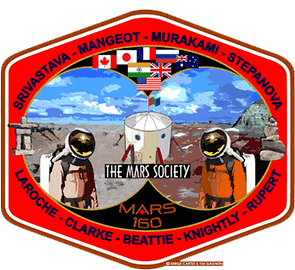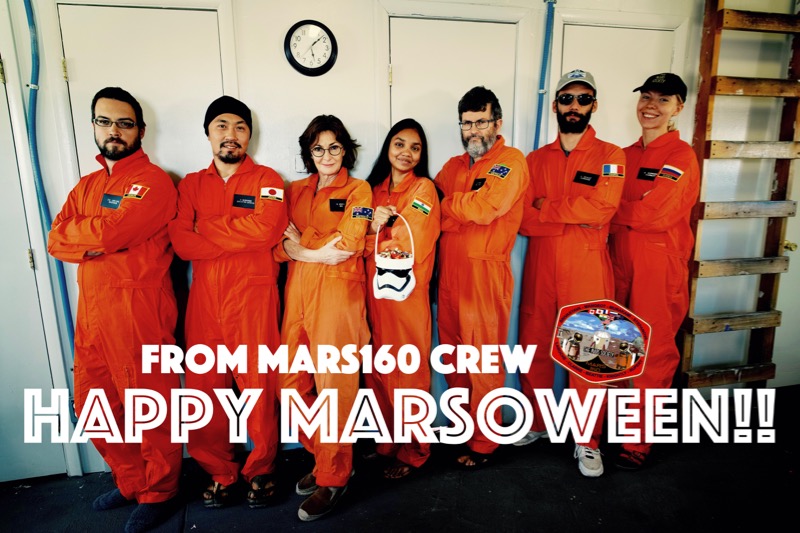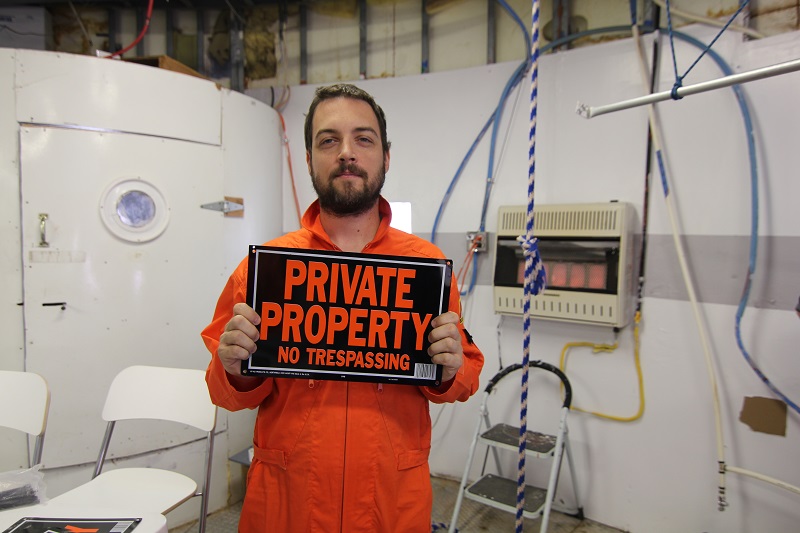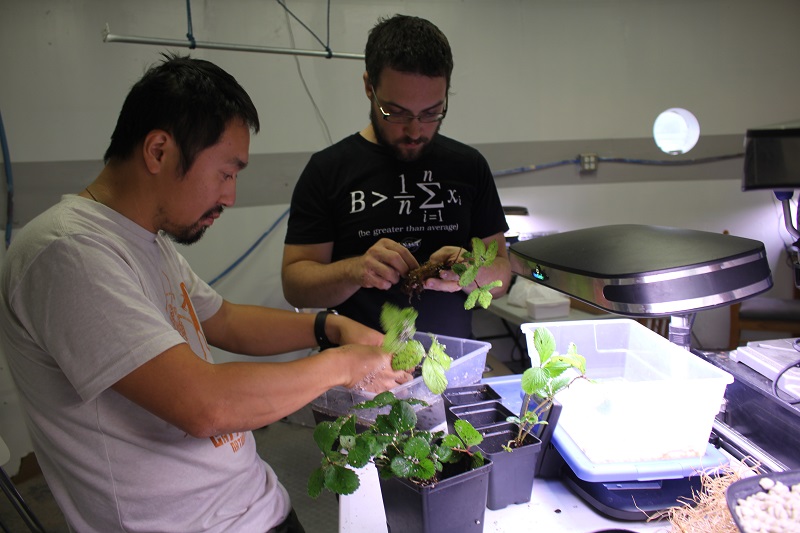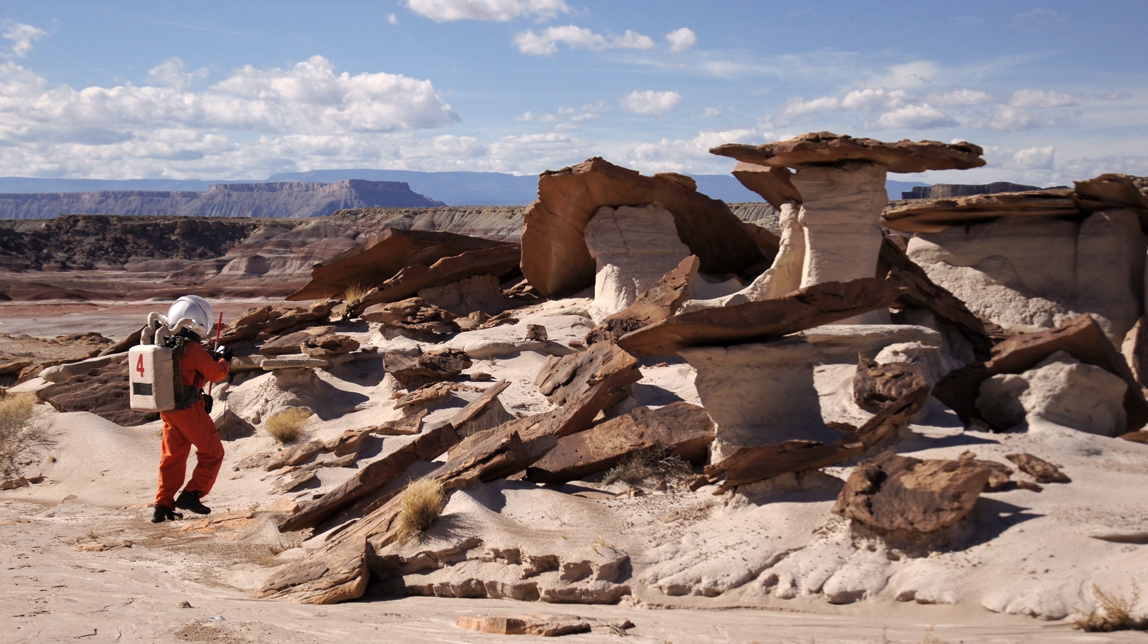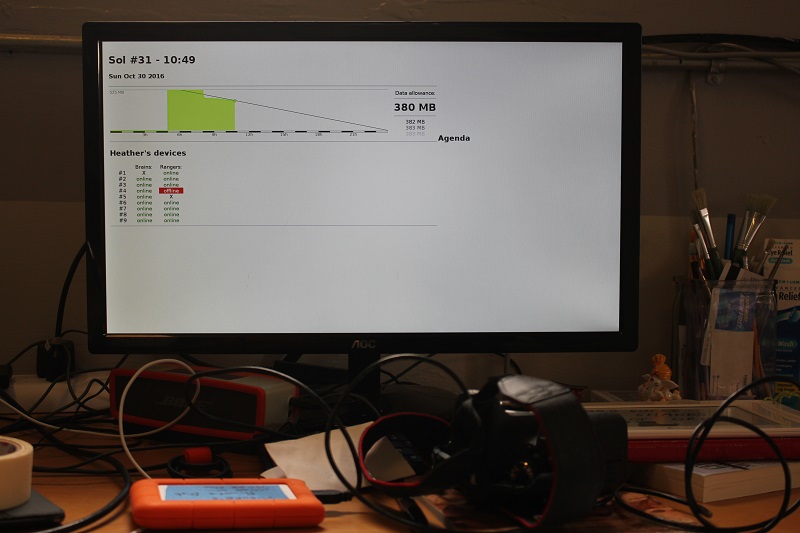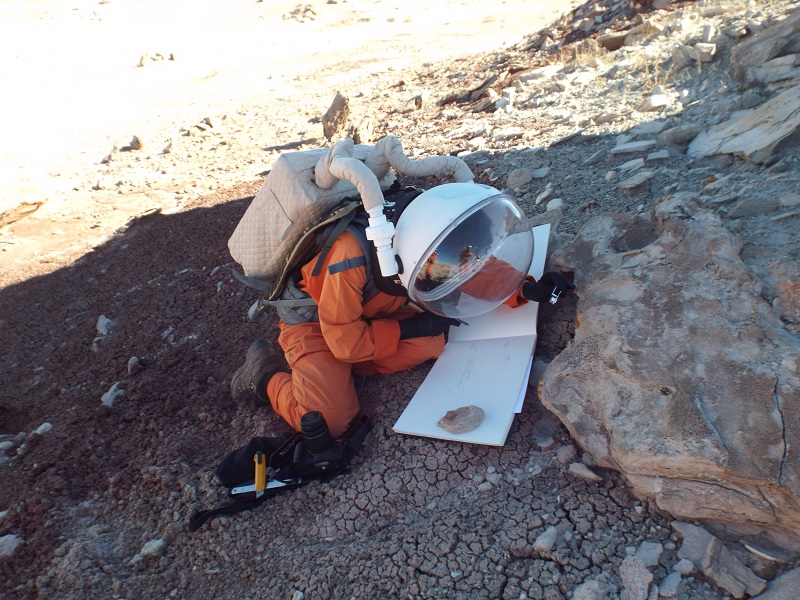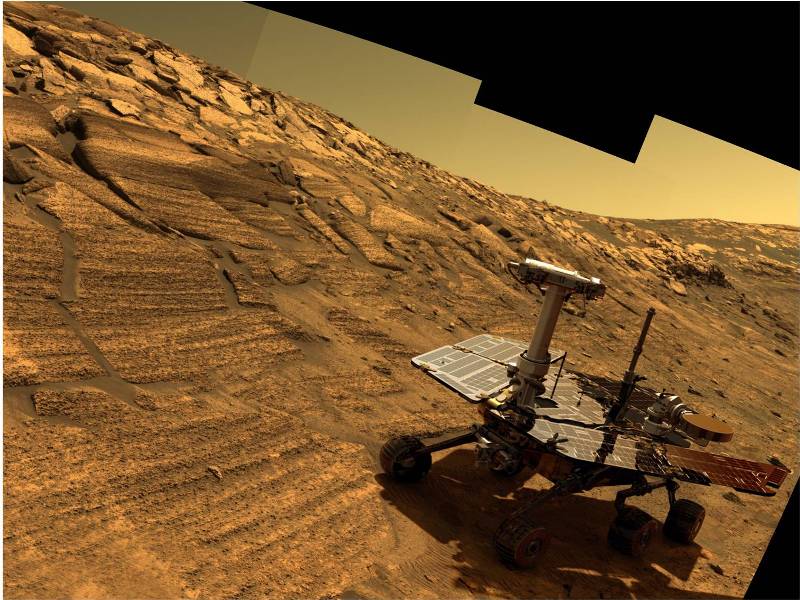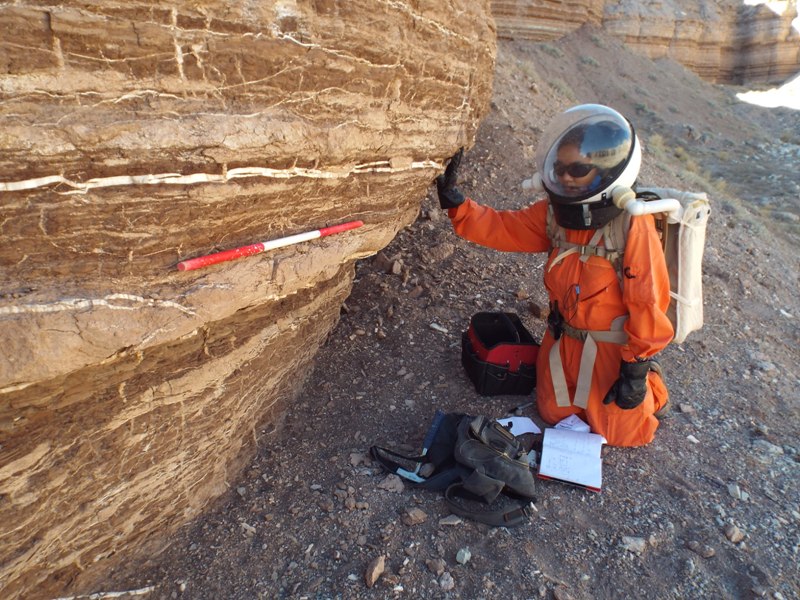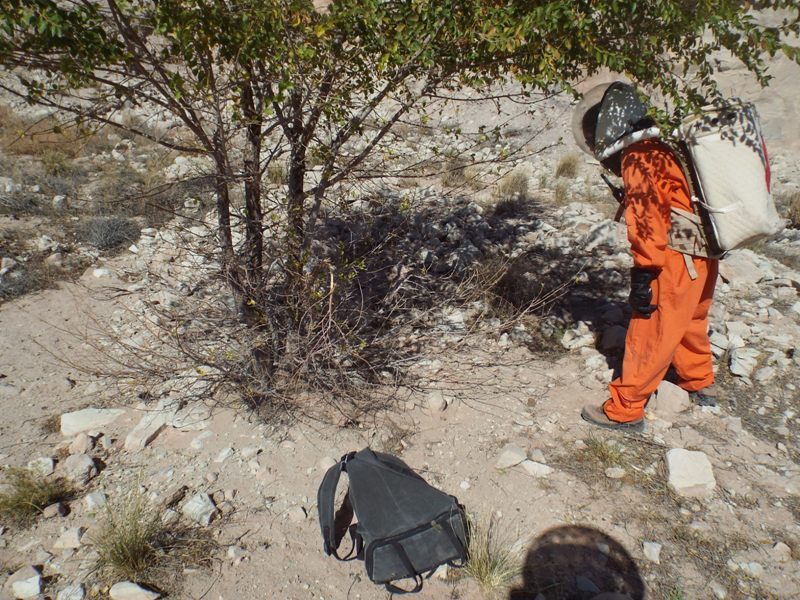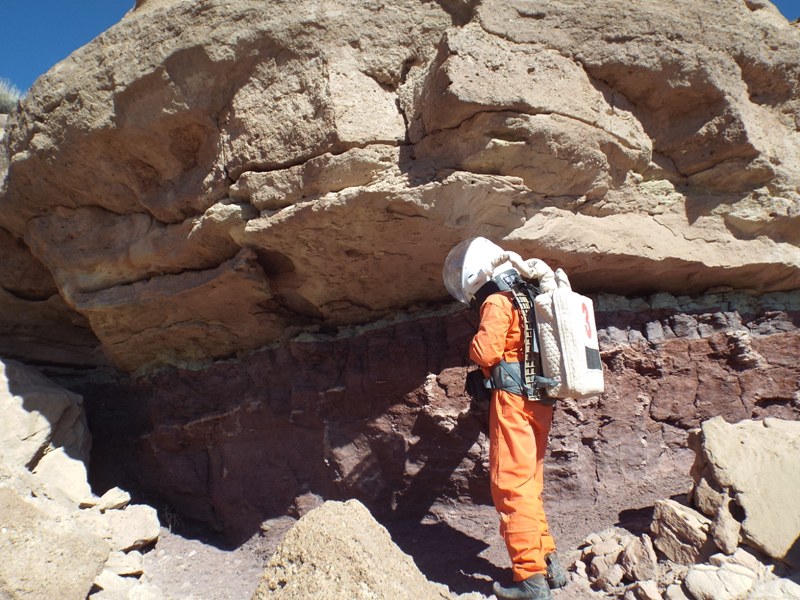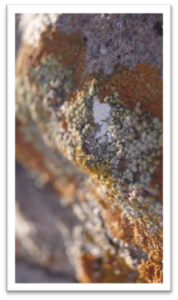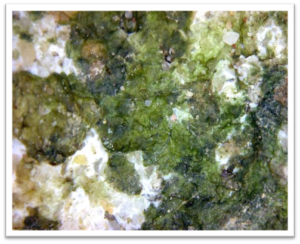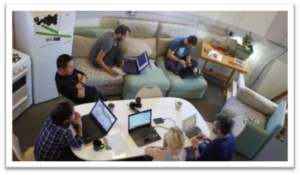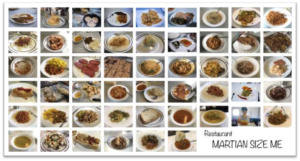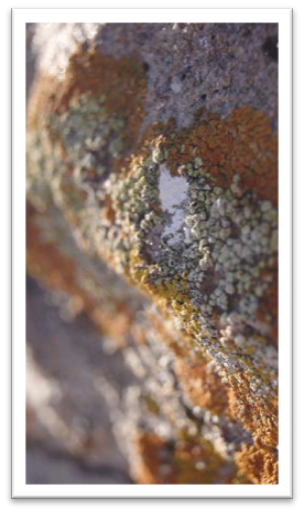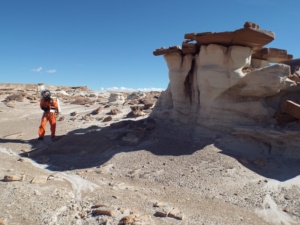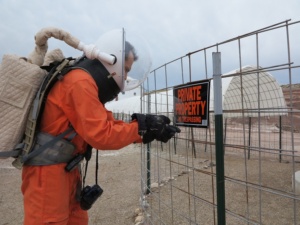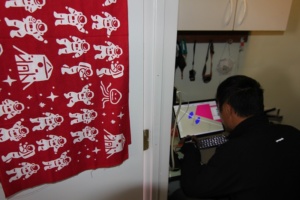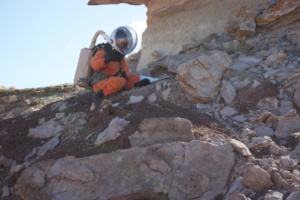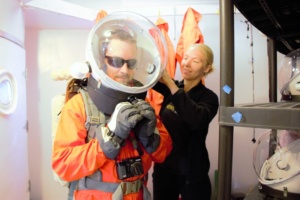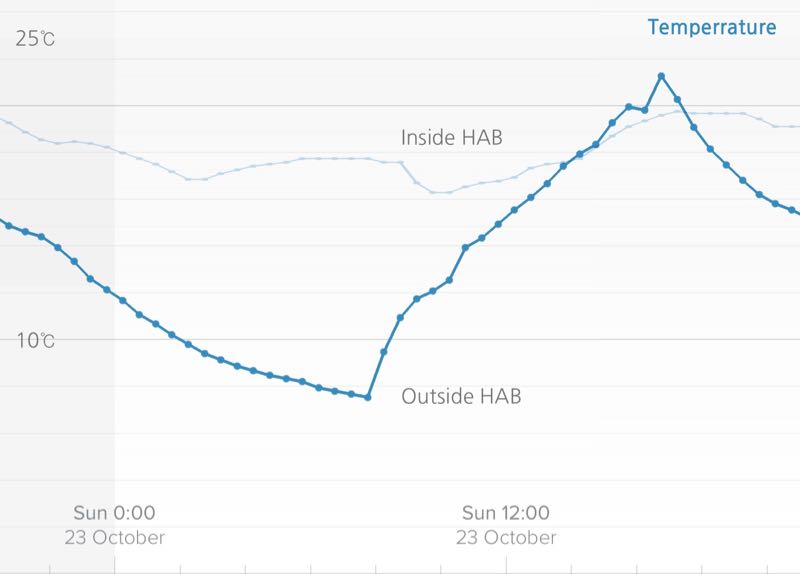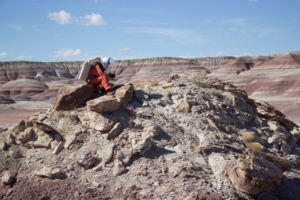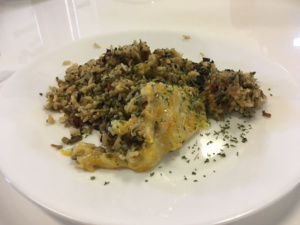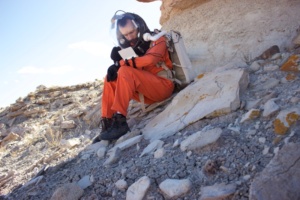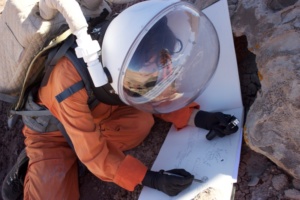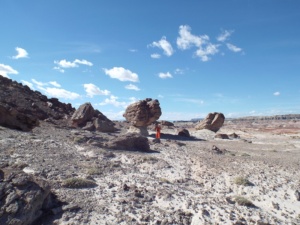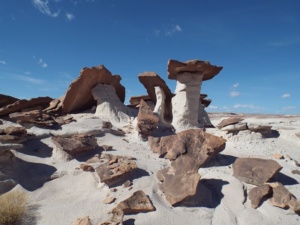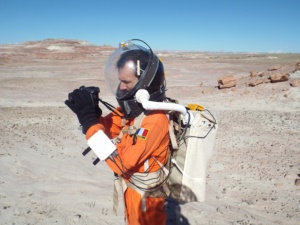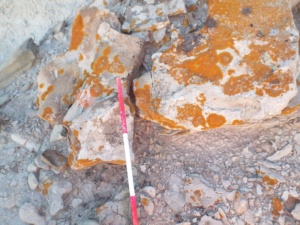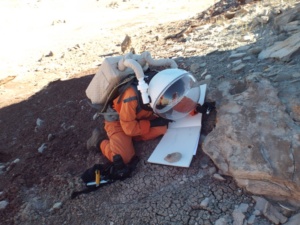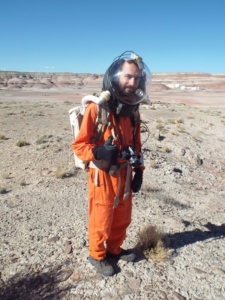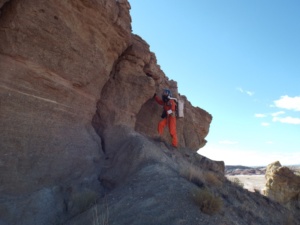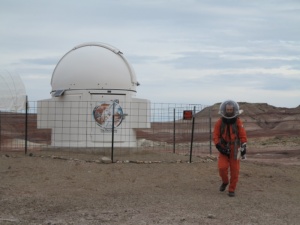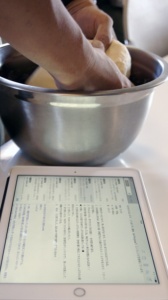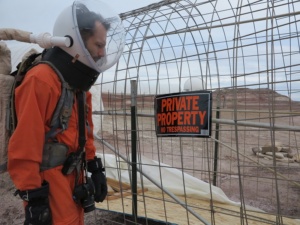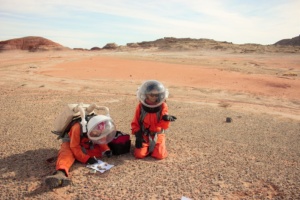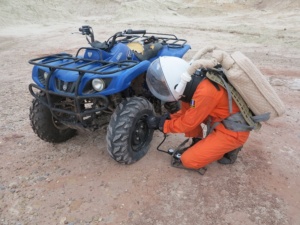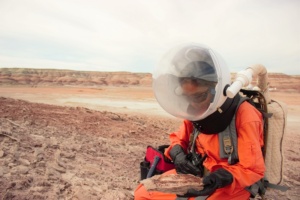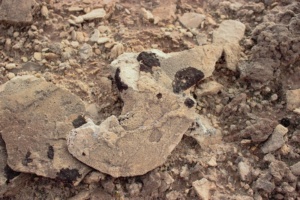
Archive: Oct 2016
Sol Summary – October 31st
Person filling out report: Anastasiya Stepanova
Summary Title: Marsoween
Mission status: Operations are nominal
Sol activity Summary: The crew was catching up with their projects and reports, since the coming week will be busy with EVAs. Operations plan for the EVA experiment done. BLSS project is going well, some plants already have the first leaves and the crew is very happy. Food inventory done, therefore crew will understand better what to take to Arctic. Girls did one hour of yoga.
Anomalies in work: No
Weather: Cloudy
Crew Physical Status: Good
EVA: No
Crew Photos – October 31st
Sol Journal – October 31st
The letters or Martian emails
Every year Mars Desert Research Station opens its doors to the diversity of the crews in terms of research projects, countries and age. In the fall of 2016 Mars Society started first part of the unique mission Mars Desert – 80. Instead of the usual two weeks rotation our crew Mars 160 will live in simulation for 80 days.
The time flies fast here and we already halfway through of the simulation. Since the isolation is the part of our Mars Analogue mission, we communicate with the Earth by several means. To who do we write the most? Our mission support team! Every day reports on different subjects are almost the same as on International Space Station. They are divided into two parts: for public and for internal issues. For the public it can be creative reports: pictures, videos, audio records, drawings, space dictionary, the phrase of the day, journalist reports and narratives. We have a talented crew, which from time to time write stories about our packrat Jerry, “Doctor Who” style short story and even engineering narratives. For the internal issues the reports are: engineering, science, health and safety, EVA. In second place the public outreach work: Annalea Beattie publishes her in-depth articles at Space.com every week, other crew members publish their small stories on social networks and some prepare articles for National Geographic Japan and several Russian medias.
Only at third place of importance is the communication with our family and friends. Since our internet connection is very limited, no coverage for mobile phones to work. We experience almost the same delay as if it would be on Mars. No Skype, phone calls and real time communication. Just like back in the old days of new continents explorations. At first, it seemed harsh, but in reality, you actually appreciate every letter you receive from beloved ones and spend quality time to write the answer back. In this beautiful desert, we have time to pause and analyze our life, therefore transform it into a letter or a diary. In big cities this pausing moment to grasp and think are luxury. We got used to it fast and now enjoy the silence from the noisy world outside. The appreciation of the time stood still comes with each day and the beauty of the life opens with richer colors.
Science Discussion – October 31st
WHERE DO EVAS COME FROM?
Jon Clarke and Annalea Beattie
The basic unit of exploration at MDRS is the EVA, or Extra-Vehicular Activity. This term comes from the earliest days of the US space program and was entirely appropriate for the occasions when astronauts first went outside their spacecraft. It has continued to be used for excursions on the lunar surface, marathon assembly activities on the International Space Station, and complex repairs to the Hubble Space Telescope. The first explorations on the surface of Mars will also be called EVAs, but as people progress further and further from their Mars stations, including multi-day excursions in pressurised exploration vehicles (PEV), a whole new terminology may need to be evolved. In the meantime we continue to use the established terms.
While EVAs both here and in space are well-documented, the processes by which EVA goals of exploration are determined are often unseen. One of my projects on the Mars 160 expedition is to work with Annalea Beattie here on the expedition, Bill Clancey of the Institute for Human and Machine Cognition, and others to explore this and other operational questions. It has been said that people who like sausages should not see them being made. Perhaps the same is true of EVAs! But let’s not be put off, but delve into the details of this process.
Astronaut Jack Schmitt on the Moon during Apollo 17 (NASA image)
Exploration EVAs, which have not occurred since the end of the Apollo 17 mission, are designed to answer specific questions and gather particular data. Sometimes the goal has been defined as “hypothesis testing”, a terminology based on the scientific philosophy of Karl Popper. For instance, this methodology has been extensively used to elect the landing sites for robotic Mars missions and to guide sol-by-sol operations, as described in Bill Clancey’s 2012 book “Working on Mars”. Likewise, the Apollo 15 mission validated the hypothesis that the lunar highlands were made of the rock anorthosite. Less well known is that the Apollo 16 mission falsified the hypotheses that the Descartes highlands were volcanic. Does this mean that Apollo 16 was a failure? Not at all! Not only did it show that the photo-mapping assumptions were false and needed to be upgraded, much valuable data was collected as to what was actually there. Failure is as instructive in science as success.
Opportunity Mars rover superimposed out outcrop at Endeavour crater (NASA/JPL image)
In my experience the idea for a geological field excursion or a simulated EVA often does not come from an abstract desire to test hypotheses, but from a perception that an area is interesting. This based on past experience is simply that an area is unknown and needs to be explored and what is actually there documented. Hypotheses are generated further down the track, as the existing data is reviewed prior to the excursion or EVA, or even as a result of a previous EVA. These can be tested in the field or on data collected in the field. Because of the speed at which direct human explorers can cover ground and assess sites, often multiple objectives can be met on a single excursion of EVA.
All of these approaches have their place on the M160 expedition. One recent EVA was driven by the need to test hypotheses that particular small mesas were inverted channels. Other small mesas were already known to be inverted channels but were visited to collect palaeocurrent data. During the course of the EVA several new hypolith localities were discovered for detailed characterisation at a later date. At this stage our understanding of hypoliths in the MDRS area is so poor that we have no hypotheses to test. Instead we must find the occurrences and then document them. From these data we will generate hypotheses for further testing by later crews and to compare our findings here with those in the Arctic during the second phase of our mission.
Sampling gypsum for halophiles
Another EVA, part of an excursion away from the station in an analogue “PEV”, was to a well-understood exposure of the Summerville Formation, a bedded gypsum rich deposit. Our goal was to sample the gypsum for laboratory analysis for preserved halophytic microorganisms trapped during the deposition of the gypsum on a Jurassic mud flat, or during fluid movement deep underground. We serendipitously found a new hypolith location for future study on the same EVA. A second EVA from the PEV tested hypotheses that a different lichen assemblage to that growing on rocks would be found on woody debris round the tall shrubs occurring at this locality. We appear to have falsified this hypothesis but found new and well developed lichen sites associated with moist sandstone boulders shaded by cliffs.
Looking for lichens on woody debris
On Mars most EVAs are likely to be based on objectives proposed by a large and Earth-based mission support team. The astronauts performing the EVAs will not be fully independent agents, but representatives of a much larger organisation and community. But nor will they be robots, mindlessly acting the commands of a remote mission control. Nor can they be as tightly controlled as the astronauts were on the Apollo missions. Even here human ingenuity circumvented the strictures of mission control, a shown by the story of the “seatbelt basalt” on Apollo 15. Dave Scott spotted an unusual rock along the way back to the LM. Judging that they would not be given permission to make an unscheduled stop for the sole purpose of sampling he instead stopped to “fix a seatbelt.” The sample “coincidentally” ended up inside the Scott’s pocket. With the greater time lag on a crewed Mars mission will require much higher autonomy, a lesson that may be difficult for mission managers to learn. As they gain more local tacit knowledge they will want greater autonomy from mission control.
The unexpected – finding Jurassic mammal burrows
As on a real future crewed Mars mission, many of our EVAs are generated by people not actually present on site. External researchers, part of our larger team, have requirements regarding documenting and sampling hypoliths and lichens that we have to meet. These must be integrated in our schedule of 4-5 EVAs per week. Their perceptions, understanding, and expectations of the area must be balanced against our own increasing knowledge of our environment. How this process of negotiation and integration to ensure that all goals are met actually works on a mission such as ours is also part of our study. Through documenting, understanding, and eventually publishing these processes we will improve the knowledge base that will guide the planning of future EVAs on the Moon, Mars and beyond.
30 Day Report
Hello from Mars,
火星からこんにちは (Kasei kara konnichiwa),
Привет с Марса (Privet s Marsa),
मंगल ग्रह से नमस्ते (Mangal grah se Namaste),
Salutations Martiennes,
We are 7 people living in the MDRS, (almost) operating as a manned Mars mission crew. We come from all over the world and enjoyed not only our high and down times in such small habitat. We share our cultures, our knowledge and our passion for the Red Planet.
This mission is about science and as such, scientists around the world support us. The overall program is ambitious, from geological morphology study to DNA analysis of microorganisms with unprecedented engineering projects and international outreach connection. The main idea behind the Mars 160 mission is to take the challenge of performing such a diverse program as it would be done on Mars…
Science
Scientific research on the Mars160 expedition is distributed program. The work carried out by the field crew is just the visible part a larger research team who identify the questions, design the experiments, supply the equipment, and advise the field team.
In 30 days, the field crew have performed 165 crew-hours of simulated EVAs, covering a large spectrum of objectives, from lichens sampling to landform investigations, geotechnical surveys and engineering maintenance. All EVAs are driven by the collaborative science program which focuses on the astrobiology aspect of Mars analogue environments – first in Utah and later on Devon Island during the second part of this mission planned for 2017. The two halves of the expedition allows us to compare similar microbial habitats and equivalent microbial communities in two different environments – the Arctic cold desert (FMARS) and the Utah hot desert (MDRS).
We are studying the Earth life form adapted to extreme conditions like temperature range, long term water deprivation, and intense ultraviolet bombardment. The most evident and easiest to find organisms are lichens. They are colonies of algae and fungi and have been found most often on rocks although few of them have been sampled from the soil and wooden structures.
We have searched for and found Hypolithic microorganisms on various sites. They are cyanobacteria or algae thriving in macroscopic colonies beneath or even inside transparent rocks. The experimentation starts on the field when statistical repartition is assessed. Yet, few of them are taken back to the station because most of the remaining process requires laboratory equipment that is still in transit between Earth and Mars.
Later on during this mission, halophiles – salt loving organism – will be searched for in gypsum crystals which have been found in high quantity on several places. Halophiles get stuck inside salt crystals when they formed during evaporite deposits. At MDRS the gypsum crystals are over hundred million years old, as are the living or fossilized halophiles we hope to find! Those at FMARS will be even older. We may also find modern halophiles lurking beneath salt crusts.
The link between all the biology science objectives is the environmental context including landforms, geological substrates and their history, and the local weather. Our crew has documented the various contexts with photographs, field drawings, and written notes. The data are returned to the station for further analysis. We expect landscape processes in the Arctic to be very different to those here, so it is important to understand the various processes both here and there.
Lichens are currently identified by color reaction to various chemical contact, a process called spot test. Later on the samples will be processed under a microscope so that the spores of the lichens can be observed to characterize them. The few hypolith samples brought back are photo documented, the rest is statistical processing. We expect to repeat this process when we are in the Arctic.
While we wait for the shipped laboratory equipment to land on Mars, the science team looks forward to the much more sophisticated analyses that will be done. The expectations are high. The advanced geological and biological experiments that are prepared will yield results, contributing towards the future astrobiological exploration of Mars!
Engineering
Every single resources and hardware here is limited (put aside the air). The engineering monitoring and maintenance is the key of our well-being if it is not our “survival”. For instance, we have already experienced shortage on water and will likely happen again before the end. Including flush, cleaning, hygiene, drinking and cooking no more than 8 gallons per person of water is used. We are focused on not wasting water. Our consumption would be even higher if not for the vacuum washing machine we have here. It just uses a fairly simple thermodynamic effect to kill bacteria without using high temperature, water as a solvent or even detergent or other fancy chemical. Just hard low pressure atmosphere which would be an unlimited resources on Mars and in space.
Since the last mission at MDRS – that was two years ago for half the crew – the station and its surrounding have changed quite a bit. Like a family, the old and devoted Hab, that already hosted over 1 000 people marks the landscape from its unique footprint and is now warmly surrounded by a few other old and new additions. The greenhouse is brand new, the solar arrays and the science dome give to the area a look of a Martian thriving base. Obviously the observatory is still here and now the whole is connected by tunnels. Inside the habitat, the furniture has been replaced to make the place cozier.
We are also enjoying newly designed spacesuits, heavier than the previous ones, but definitely more fitted to the harsh environment. The large possibility to tweak the fittings to each crew-member’s morphology and the airflow designed to prevent fogging are well appreciated improvements.
With the nice spacesuits, an interactive user interface is being developed. This project aims at improving EVA operations and field science but not only that, it should make EVAs more realistic and embedded to the work conducted in the station. The first prototype is now operational and will be tested during the next days. Soon, it will be integrated as a key component tool into the field science.
Outreach
Unlike the great exploration story of the past century, the intrinsic isolation that comes with exploring Mars does not prevent us to communicate with Earth-based teams and those we left back at home. Internet is our only – and limited – communication channel through which go our reports, pictures, videos and messages to our loved ones. We are not alone!
Our priority is to keep the base operational and the crew healthy. Consequently, our reports to mission-support are the main communication basis. Then the outreach goes mainly with the daily posts that everyone on Earth can access to, on the Mars 160 mission website. Not only that, articles are published weekly on Space.com, some crew-members write for their respective national media or respond to email interviews and we spend some time on the various social media as well. Lastly, our private messages complete the news that our relatives get from us. While we are used to live in hyper-connected societies, not having direct communications is a strange feeling. We do not feel the pressure of common society but the pressure of our Earth-based remote science team. Still, we are our only masters here and time flies both fast and peacefully…
Life
As the work progresses, one rule should never been forgotten. Safety first! As it would be on Mars. The start of the mission has been punctuated by various training such as ATV driving – that some of us has not driven for several years or even never drove before.
Inside the station it is pretty much like living in half garage (downstairs) and half submarine quarters (upstairs). As we live in a remote place we still must be careful regarding the inherent hazards of such a lifestyle. Even though, despite the dangers and the workload, individual health interviews show that the health and the morale of the crew is quite good. Over here, we keep the form and the good spirit thanks to the large variety of the food recipes, physical activities and leisure times.
The food is dehydrated or canned. It is just a habit to take before being quite comfortable to cook it. We take pleasure to cook every meal as cultural diversity entertainment. This is Martian food: Martian-French, Martian-Aussie, Martian-Canadian, Martian-Russian, Martian-Indian, Marian-Japanese, which restaurant do you like best?
Part of the crew is fond of yoga, done almost every day downstairs, to keep shape and flexibility. We also have improvised some workout equipments such as a pull-ups bar and a climbing rope. Some should end this mission with more physical abilities than when they started.
Our last social entertainment activity is watching TV shows episode and one movie during weekend evenings. Sunday is the day-off during which each crew-member is free to have leisure time. Usually this day is really enjoyed since the rest of the week is spent on working.
Life on Mars is hard. The work would be already challenging without the constraints of the simulation. Despite the difficulties of living a constrained life, the current Mars 160 crew is performing an unprecedented science, engineering and outreach program. But we are here because we all believe that a human to Mars mission is much more than hard work in difficult circumstances.
Hopefully, when it is stressed, the human mind enjoys little things. A beautiful sunrise on the desert, the smell of the coffee, a familiar music or a relative picture. These little things have the power to transport you to the other side of the world or back in time. Besides, the odds have bounded the crew with strong empathy for each other and friendship. Actually, life on Mars makes you feel human.
30 Day Report – Japanese Translation
Hello from Mars,
火星からこんにちは (Kasei kara konnichiwa),
Привет с Марса (Privet s Marsa),
मंगल ग्रह से नमस्ते (Mangal grah se Namaste),
Salutations Martiennes,
僕ら7人はいま(模擬)有人火星ミッションのクルーとしてMDRS火星基地に滞在している。世界中の様々な国から集まった僕らは、良きにつけ悪しきにつけ、この小さな基地を頼りに生きていく時間を愉しんでいる。
このミッションの中心は何と言っても「科学」にあって、世界中の科学者たちが地球から僕らをサポートしてくれる。地質学的な体系調査から微生物のDNA解析にいたる幅広い研究や、前例のないエンジニアリング・プロジェクト、あるいはアウトリーチ活動など、多くの意欲的なプロジェクトが僕らの仕事だ。Mars160ミッションの最たる存在意義は、この本当に多種多様なプログラムが、火星でも実現することが可能なのかを、リアルなフィールドのなかで試すをことにある。
Science
Mars160の科学探査には、実にさまざまな形で、多くの人たちがかかわっている。宇宙服を着て、目に見える形で実際にフィールドに出ている僕らはそのほんの一部にすぎず、研究の目的や手法を提案するチーム、装備を供給してくれるチーム、アドバイザーとして僕らをサポートしてくれるチームなどがいる。
この30日間で、僕たちフィールドクルーは165時間の船外活動を行った。地衣類のサンプリングから地形調査、地学的測量、基地の保守点検など、船外活動の目的もさまざまだ。前半の米ユタ州、そして2017年に予定している後半の北極圏デヴォン島。二つの場所で行うすべての探査は、宇宙生物学的側面から模擬火星環境を研究するプログラムと共同で実施される。北極圏の寒冷砂漠環境(FMARS)と、ユタの温帯砂漠環境(MDRS)、その二つの異なる環境で同じような微生物やその群生の比較調査を実施する。
僕たちは、温度差、極乾燥、強烈な紫外線など、地球上の極限環境下で生物がどのように適応し、そして生存しているのかに関心を持っている。その代表となる有機体が地衣類だ。地衣類は岩石の表面上に藻類や菌類と共生繁殖している生物で、まれに土壌や樹木で見つかることもある。
僕たちはまた、さまざまな場所で光合成有機物を探している。この有機物は緑色の細菌か藻類で、肉眼でやっと見えるくらいの大きさの繁殖群を透き通った石の内部や表面に作っていることが多い。現在の主要な探査のやり方はフィールドでの統計調査だ。サンプリングをし、さらなる解析を行うためには、基地の研究設備が整うのをもうしばらく待たなければならない。
他にもミッションの後半には、塩を好む原核生物である好塩菌の探査も行う予定だ。好塩菌はおそらく、この場所のさまざまな場所で採取が可能な石膏の結晶石のなかで見つかるはずだ。好塩菌は塩分を含む沈殿物が結晶化する際に、その内部に取り残されることが知られている。MDRSで見つかる石膏の結晶石は、数十億年前のものであることが分かっている。太古の好塩菌の化石が見つかるかもしれないし、FMARSのものはもっと古い菌かもしれない。もちろん塩の層の下に潜んでいる、いま生きている好塩菌を見つけることも忘れちゃいけない。
生物科学はあらゆる側面で、地形や地層、歴史、気候などの環境要素と密接な関連を持っている。僕たちは写真や映像、スケッチ、文章など、あらゆる手段をフルに使って記録を行っている。フィールドから持ち帰ったこれらのデータは、基地の中でさらなる解析が行われる。北極のフィールドは、この場所とはきっと多くのことが異なっているだろう。だからこそ、僕たちはここでさまざまな手法を試し、その特性を十分に理解しておかなければならないんだ。
採取された地衣類サンプルは今、SPOT TESTとよばれる、ある種の化学薬品との色反応による同定解析の過程にいる。その後に顕微鏡を使って胞子の特徴を観察する予定だ。いくつかの有機体サンプルは写真によって記録され、残りは統計調査を行っている。僕らは同様の調査を北極圏でも行う予定だ。
ここ火星には、研究室で使用する予定の、もっと高度な解析を行える機器がまだ到着していないため、サイエンスチームはそれを心待ちにしている。その期待は高い。高度な地質学的・生物学的実験機器は、きっと近い将来の火星生物探査に直結する、多くの結果を提供してくれるはずだからね!
Engineering
ここでは火星と同じく、すべての資源が限られている(空気だけは除いて)。モニタリングやメンテナスといった、エンジニアリングの側面は、僕らの日常が緊張感のあるサバイバルの様相を呈さないための、とても大切な鍵となる。たとえば僕らはすでに一度、水資源が枯渇するという事態を経験していて、それがまたわずかな注意を怠れば、再び起こりうることなんだと学んだ。トイレや掃除清掃、飲料水、調理に至るまで、僕らの水は一人当たり約30リットル以下に制限されている。だけど僕らは、水の使用量を減らすことを目的にしているわけではないんだ。もしも僕らが持ち込んだ「真空洗濯機」がなかったら、水の消費量は幾分か増えていただろうね。汚れた衣服に潜むバクテリアを、どうしたら水や洗剤を使わないでも取り除くことができるのだろう?だったら火星に無限にある、この真空に近い気圧環境を利用すればいい。そんなシンプルなアイディアから、この装置は生まれたんだ。
約半分のクルーにとっては、前回の最終選考ミッションから約2年間の月日が経っている。おもえば、その間に基地の様子はだいぶ変化した。この古くて物言わぬ家、HABは、これまで1000人以上のクルーたちを受け入れてきた。この地を訪れた皆にとって、HABはまるで家族のような存在だ。そして今は、少しばかりの新しいアップデートを加えて、また僕らを温かく包んでくれている。僕らがGreenHABとよんでいる温室は新しく作り替えられて、新たに太陽光発電パネルとサイエンスドームを加えて、HABはちょっとした火星研究所のようにも見える。もちろん天文観測台も健在で、すべての建物がトンネルで連結されている。基地の内部へと目を向ければ、新しく入れ替えらえた家具が居心地の良い雰囲気を作ってくれている。
それにね、宇宙服も新しくなったんだ。以前のものと比べてだいぶ重くはなったけれど、格段に頑丈になった。個々のクルーの体型に合わせて微調整が出来るようになったし、空気の吸入装置も改善されてヘルメットのレンズも曇りにくくなったんだ。
この新しい宇宙服に加えて、近々新たな船外活動支援ツールも登場する予定だ。このプロジェクトは、僕らの船外活動や科学探査をより良いものにしてくれるのはもちろん、このツールによって収集される様々なユーザーデータにも期待が寄せられている。最初の試験機はもう間も無くフィールドでテストされる。フィールドで探査を行う研究者たちにとって、欠かせないツールになる日も近いかもしれない。
Outreach
20世紀の大いなる探険史のそれとは違って、これから火星へと旅たつ火星飛行士たちは、地球へと無事に帰ってくるまでの期間、常に地球にいる支援チームによるサポートを受けながら活動するのが基本だ。低サイズの文章や画像に限られてはいるものの、インターネットを介した定時通信回線が、僕らと支えてくれる人たちとの間にある唯一の伝送手段だ。
ミッションの基礎となる情報を欠かさず伝え合うこと。常にクルーたちの無事を確認し合うこと。それらが通信の最優先事項であり、その情報は日々のレポートという形に集約されている。クルーたちからのこのレポートは、Mars160公式ページで誰でも見れるようになっているので是非見て頂きたく思います。それ以外にも、毎週 space.com に記事がアップされ、それぞれのクルーもまた母国のメディアや個人のSNSなどに情報をアップしているので、そちらも是非(でもクルーからの、家族や特別な人へ宛てたメッセージは公開されていませんので悪しからず)。何もかもが通信で繋がっている世界に慣れていたから、なかなか密に連絡を取ることができない今の状況をもどかしく感じる瞬間もある。支援チームとの定時交信を途切らせてはいけないプレッシャーを感じることもある。でもきっと僕らなら上手にやれるはずだ。
Life
ここで生きていく上で、一つだけ忘れちゃいけないルールがある。「Safety first!(安全第一!)」これはきっと火星でも同じだ。だからミッション開始時にはたくさんの訓練を行った。たとえばバギーの操縦訓練。初めて運転を経験するクルーもいたし、それに他のみんなも久しぶりだったしね。
さしづめ基地の中は、ガレージが半分(1階)潜水艦並みの居室が半分(2階)といったところかな。文明圏から離れて暮らしていく上で、日々の生活と切り離すことのできないさまざまなリスクに、僕らは常に目を光らせなければならない。そんな気の抜けない生活を送っているのにもかかわらず、個々のクルーたちへの問診の結果を見ると、健康や士気を落としている者はいない。僕たちを支えてくれているのは、毎日の食事や運動、余暇の時間だ。
すべての食材は、乾燥食材か缶詰だ。少しばかり余計な下ごしらえの時間が必要なこと以外は、普段の食材とそう変わりはしない。国籍の異なるクルーたちがいるおかげで、毎日違った国の料理が楽しめるんだ。これが僕たちの火星の食事だよ(写真)。火星風フレンチ、火星風オージー料理、火星風カナディアン、火星風ロシア料理、火星風インド料理、火星風和食料理、みんなはどの料理が食べてみたいかな?
体型や柔軟性を維持するために、ほぼ毎日のペースでヨガを実践しているクルーもいるよ。他にもお手製の懸垂棒や昇降綱を基地の梁に取り付けたりして、トレーニングしている。もしかしたらミッションが終了する頃には、最初の頃より身体能力が上がっているかもしれないね。
もう一つのお楽しみは、週に一度の映画と連続ドラマ鑑賞だ。だいたい週末の夜がお決まりの日。日曜日は休暇日となっているので、クルーそれぞれが自由に時間を過ごしている。もちろん完全に休めるわけじゃないんだけれど、仕事するにしろ休むにしろ、自分で好きに時間を使えること自体が嬉しいことなんだ。
火星の毎日は本当に忙しい。火星シミュレーションという制約がなかったとしても、僕らの従事している仕事はやりがいのある試みだ。過去にも例のないこんな厳しい環境のなかで、Mars160のクルーたちはサイエンスやエンジニアリング、アウトリーチのプログラムに追われている。でも僕らはここにいるんだ。いつか火星に人類を送り届けることが、それだけの価値があることだと信じているから。
ひとはストレスを感じたとしても、小さな喜びに希望を見出すことができる。美しい日の出、コーヒーの香り、お気に入りの音楽、そして大切なひとの写真。このちょっとしたことの数々が、僕らをここではない何処かへと誘ってくれる。そして何よりも、ここでの困難を乗り越えるためには、仲間たちと分かち合う感情やそこから生まれる友情が大切なんだ。火星に生きることは、僕たちが人間なんだってことを、気付かせてくれることなんだ。
30 Day Report – Russian Translation
Hello from Mars,
火星からこんにちは (Kasei kara konnichiwa),
Привет с Марса (Privet s Marsa),
मंगल ग्रह से नमस्ते (Mangal grah se Namaste),
Salutations Martiennes,
Нас семеро, живущих на Марсианской исследовательской станции в пустыне, работая почти в таком же режиме как экипаж пилотируемой Марсианской миссии. Мы прибыли из разных уголков планеты Земля. Вместе мы преодолеваем не только взлеты и падения, но и делимся своей культурой, своими знаниями и своими мечтами о красной планете.
Основное направление нашей миссии – это наука. Ученые из разных стран работают с экипажем над совместными проектами и постоянно поддерживают нас. Общая программа миссии довольно амбициозна: исследование геоморфологии; анализ ДНК микроорганизмов; уникальные инженерные проекты и международная научно- популяризаторская деятельность. Главная идея, стоящая за миссией Марс 160, это выполнение столь разнообразной программы, на таком же уровне, как если бы это было сделано экипажем на Марсе…
Наука
Научная программа экспедиции Марс 160 распределена на несколько частей. Полевые исследования, выполненные экипажем, это лишь видимая часть большой исследовательской группы, которая разрабатывает эксперименты, предоставляет оборудование, определяет вопросы для исследования и составляет рекомендации.
В течение 30 дней экипаж провел 165 часов симуляции ВКД (вне корабельная деятельность) на марсианской поверхности, затрагивая разнообразные аспекты, такие как: сбор образцов лишайников, исследования формы рельефа, геотехнические изыскания и инженерное обеспечение. Все ВКД проводятся под эгидой совместной научной программы, которая фокусируется на астробиологическом аспекте Марсианского аналога окружающей среды: сначала в пустыне штата Юта (США) и позже, во время второй части миссии в 2017 году, на острове Девон (Канада, Арктика). Две части экспедиции позволят нам сравнить схожие места обитания микробов и эквивалентных микробных сообществ в двух различных средах – холодная пустыня Арктики (станция FMARS) и горячая пустыня Юты (станция MDRS).
Мы изучаем Земные формы жизни, приспособленные к экстремальным условиям (температура, длительное пребывание без воды и интенсивная ультрафиолетовая бомбардировка). Наиболее очевидные организмы, которые легко обнаружить – лишайники. Это колонии водорослей и грибов, которые чаще всего обитают на камнях, хотя некоторые из них были обнаружены в почве и дереве.
Были осуществлены поиски гиполитических микроорганизмов в различных локациях, которые увенчались успехом. Гиполиты – это цианобактерии и водоросли процветающие в макроскопических колониях под или внутри прозрачных пород. Эксперимент начинается на поверхности пустыни, когда оценивается статистический передел. Позже некоторые из образцов будут взяты обратно на станцию, так как большая часть оставшегося процесса требует лабораторного оборудования, которое до сих пор в пути между Землей и Марсом.
В следующие 30 дней будут осуществлены поиски галофилов (организмы, любящие соль) в гипсовых кристаллах, которые были обнаружены в большом количестве в нескольких местах. Галофилы застревают внутри кристаллов соли, которые образуются в процессе эвапоритовых месторождений. На MDRS кристаллам гипса более ста миллионов лет, а значит столько же живым или окаменелым галофилам, которые мы надеемся найти! Галофилы на станции FMARS будут еще старше. Мы также можем найти новые галофилы, скрывающиеся под коркой соли.
Связью между всеми научно-исследовательскими целями биологии является экологический контекст, который включает в себя формы рельефа, геологические субстраты и их историю, а также местную погоду. Наш экипаж задокументировал эти разнообразные контексты в виде фотографий, полевых рисунков и письменных заметок. Данные были отправлены на станцию для дальнейшего анализа. Мы ожидаем, что ландшафт в Арктике сильно отличается от Юты, поэтому важно понять различные процессы, как здесь, так и там.
Лишайники могут быть определены с помощью цветовой реакции к различным химическим компонентам, этот процесс называется «капельный анализ». В дальнейшем образцы будут проанализированы под микроскопом для наблюдения спор лишайников и их дальнейшей характеристики. Несколько образцов гиполитов были взяты обратно на станцию и фото задокументированы, остальные использованы для статистической обработки. Этот процесс будет повторен во время второй части миссии в Арктике.
Пока мы ожидаем доставку лабораторного оборудования на Марс, научная команда с нетерпением ждет проведения гораздо более сложных анализов. Ожидания высоки, так как проведенные передовые геологические и биологические эксперименты будут способствовать будущем астробиологическим исследованиям Марса!
Инженерное дело
Все ресурсы на станции ограничены, кроме воздуха. Инженерный мониторинг и обслуживание станции являются ключевыми моментами в поддержании нашего хорошего состояния и выживания. Например, мы уже испытали нехватку в воде, и подобная ситуация больше не повторится до конца миссии. Норма потребления воды 30 литров на человека в день. Это включает в себя: питье и приготовление пищи, личная гигиена, стирка и уборка, туалетный слив. Мы сфокусированы на рациональном потреблении воды. «Вакуумная стиральная машина» помогает нам не тратить воду на стирку одежды. В ней использованы простые термодинамические эффекты для истребления бактерий без использования высокой температуры, воды в качестве растворителя или моющих средств и других фантазий химической индустрии. Просто нужна атмосфера с низким давлением, которая будет в достатке на Марсе и в космосе в целом.
С момента нашей последней симуляции на станции MDRS прошло несколько лет, и обстановка изменилось. Старая добрая станция, на которой побывали более 1000 людей, как всегда выделяется среди красных холмов Юты, но теперь она окружена новыми конструкциями. Новая оранжерея, научная лаборатория и массивные солнечные панели создают впечатление настоящего Марсианского поселения. Разумеется, обсерватория все еще на месте и теперь все строения соединены между собой тоннелями. Внутри станция была преобразована, почти вся старая мебель была заменена и гостиная-столовая теперь самое уютное место.
Мы с удовольствием испытываем новые скафандры, которые тяжелее предыдущих, но больше соответствуют нагрузке и окружающей среде. Теперь рюкзаки с вентиляционной системой можно адаптировать под каждого члена экипажа, а шлем больше не запотевает.
С новыми скафандрами также разрабатывается новый интерактивный пользовательский интерфейс. Этот проект направлен на улучшение работоспособности экипажа при ВКД, на получение точной информации с полевых работ и на достижение реалистичности симуляции. Первый прототип уже функционирует и будет протестирован в ближайшие дни. В скором времени, он будет интегрирован как ключевой инструмент для полевых исследований.
Популяризаторская деятельность
В отличии от первооткрывателей прошлого, изоляция, свойственная освоению Марса, не исключает общения с Землей. Интернет – это наше единственное средство для отправки отчетов, фотографий, видео и сообщений центру управления миссии, родственникам и любимым. Мы не одни!
Нашей приоритетной задачей является сохранение базы в рабочем состоянии и поддержания здоровья экипажа. Следовательно, наши отчеты для центра управления миссии являются первоочередными и основными для отправки. Популяризаторская деятельность миссии выражается в ежедневных журналистских отчетах, интересных и образовательных заметках, которые публикуются на сайте миссии Марс 160. Помимо этого, статьи публикуются на сайте Space.com, некоторые члены экипажа пишут для международных СМИ или дают интервью, используя электронную почту, а также мы публикуем заметки и фотографии в социальных сетях. И наконец, наши личные сообщения родным и близким завершают список коммуникаций с Землей. В то время как мы привыкли жить в постоянно подключенном к сети обществе, отсутствие прямой и быстрой связи придает странное чувство. Мы больше не чувствуем постоянного давления со стороны общества, а только со стороны удаленной научной группы. И все же здесь мы остаемся хозяевами своей судьбы, а время пролетает быстро и спокойно…
Жизнь
В процессе нашей работы мы всегда должны помнить одно правило – безопасность прежде всего. Жить как, если бы мы действительно находились на Марсе. Миссия началась с различных тренировок, в том числе управление квадроциклом, так как многие из нас давно не ездили на нем или впервые столкнулись с этим.
Внутри станции ощущение, что мы живем либо в гараже (первый этаж) либо на подводной лодке (второй этаж). Так как мы живем в удаленной местности, мы должны учитывать все опасности, присущие этой среде. Несмотря на все риски и загруженность работой, индивидуальные интервью о состоянии здоровья показали, что здоровье и моральное состояние экипажа отличные. Благодаря разнообразию еды, спортивным тренировкам и времени для отдыха, мы пребываем в хорошем расположении духа.
Ингредиенты для приготовления пищи сублимированы или законсервированы. Требуется немного времени, чтобы привыкнуть к этому. Мы с удовольствием готовим и это стало частью нашего культурного развлечения. Наша еда: марсианская-французская, марсианская-австралийская, марсианская-канадская, марсианская-японская, марсианская-индийская, марсианская-русская. Какой ресторан выберете вы?
Часть экипажа занимается йогой каждый день на первом этаже для поддержания формы и гибкости. Мы также сделали импровизированный спортивный уголок с турником и альпинистской веревкой. Некоторые из нас окончат эту миссию в лучшей форме, чем, когда начали ее.
Наше последнее развлечение – это просмотр научно-фантастического сериала и фильмов каждые выходные. Воскресенье, так же, как и на Земле, выходной день. Мы можем быт предоставлены сами себе, что порой так необходимой после интенсивной рабочей недели.
Жизнь на Марсе трудна. Несмотря на сложности жизни в ограниченных условиях, нынешний экипаж Марс 160 показывает беспрецедентную научную, инженерную и популяризаторскую деятельность. Мы находимся здесь потому что верим, что люди на Марсе – это гораздо больше чем просто тяжелая работа в сложных условиях.
К счастью, в стрессовом состоянии, человеческий разум ценит и наслаждается небольшими моментами. Прекрасный рассвет в пустыне, запах свежезаваренного кофе, знакомая музыка или фотография близкого человека – все это переносит нас на другой конец планеты и в другое время. Помимо этого, испытания сплотили членов экипажа крепкой дружбой. На самом деле, жизнь на Марсе дает почувствовать себя человеком.
30 Day Report – French Translation
Salutations Martiennes,
火星からこんにちは (Kasei kara konnichiwa),
Привет с Марса (Privet s Marsa),
मंगल ग्रह से नमस्ते (Mangal grah se Namaste),
Hello from Mars,
Nous sommes sept personnes qui vivent dans la «Mars Desert Research Station» (MDRS), opérant (presque) comme un équipage d’une mission Martienne habitée. Nous venons des quatre coins de la planète et nous apprécions non seulement les meilleurs et moins bon moments dans un si petit habitat. Mais nous partageons notre culture, notre savoir et notre passion pour la planète rouge.
Cette mission est une expédition scientifique et en tant que telle, des scientifiques tout autour de la planète nous apportent leurs soutiens. L’ensemble du programme est ambitieux, allant de l’étude de morphologie géologique à l’étude d’ADN de microorganismes en passant par des projets d’ingénierie sans précédent et des liens internationaux pour la vulgarisation. L’idée principale derrière la mission Mars 160 est de relever le défi de réaliser un programme aussi divers et de l’exécuter dans les mêmes conditions qu’il le serait sur Mars…
Science
La recherche scientifique de l’expédition Mars 160 est un programme distribué. Le travail réalisé par l’équipe sur le terrain n’est que la partie visible d’un groupe de recherche plus large qui identifie les questions, conçois les expériences, et conseille l’équipe sur le terrain.
En 30 jours, l’équipage de terrain a réalisé 165 heures-humain de simulation en Activité ExtraVéhiculaire (AEV), couvrant un large spectre d’objectifs, allant de l’échantillonnage de lichens à des enquêtes topographiques, en passant par des études géotechniques et de maintenance. Tous les AEV sont pilotées par le programme de collaboration scientifique qui a comme priorité la dimension astrobiologique de l’environnement analogue à Mars – le désert de l’Utah en premier lieu et par la suite l’île de Devon durant la seconde moitié de cette mission qui est prévue pour 2017. Ces deux moitiés de l’expédition vont nous permettre de comparer des habitats microbiens similaires et des communautés microbiennes équivalentes dans deux environnements différents – le désert froid de l’Arctique à la «Flashline Mars Artic Research Station» (FMARS) et le désert chaud de la MDRS.
Nous étudions l’adaptation de formes de vies terrestres à des conditions extrêmes telles que de larges plages de variation de températures, de longue période de privation d’eau, ou du bombardement de rayons ultraviolets. Les organismes les plus évidents et faciles à trouver sont les lichens. Ce sont des colonies d’algues et de champignons et sont principalement retrouvés sur des rochers malgré que certains échantillons aient été prélevés sur le sol ou des branches.
Nous avons cherché et trouvé des microorganismes hypolithiques sur différents sites. Ce sont des cyanobactéries ou des algues qui prospèrent en colonies macroscopiques sous et parfois à l’intérieur de roches translucides. Le travail scientifique commence sur le terrain par une évaluation de la répartition statistique. Cependant, seulement quelques-uns sont prélevés pour être ramenés à la station puisque la majorité du processus d’analyse nécessite l’équipement de laboratoire qui encore en transit entre la Terre et Mars.
Plus tard durant la mission, nous allons chercher des halophiles – organismes aimant le sel – dans des cristaux de gypse qui sont trouvés en grande quantité en plusieurs endroits. Les halophiles restent piégés à l’intérieur des cristaux de sel lors de leurs formations lorsque l’eau s’évapore. A la MDRS, les cristaux de gypse sont âgés de plus d’une centaine de million d’années, tout comme les halophiles, vivants ou fossilisés, que nous espérons trouver! Ceux à FMARS seront encore plus vieux. Nous pourrions aussi trouver des halophiles contemporains qui se cachent sous des croutes de sel.
Le lien entre tous les objectifs en microbiologie est le contexte environnemental incluant les reliefs, les substrats géologique et leur histoire, et la météo locale. Notre équipage à documenté les différents contextes par des photographies, des dessins de terrain, et des notes écrites. Les données sont retournées à la station pour des analyses supplémentaires. Nous anticipons que les processus de formation du paysage seront très différents dans l’Arctique que ceux que nous retrouvons ici. Il est donc important de comprendre les différents processus à la fois ici et là-bas.
Les lichens sont actuellement identifiés par leurs couleurs en réaction à plusieurs contacts chimiques, un procédé dénommé «spot test». Plus tard les échantillons sont analysés au microscope, nous permettant d’observer les spores des lichens et ainsi nous permettre de les caractériser. Les quelques échantillons de colonies hypolithiques que nous avons ramené sont documentés photographiquement, les autres sont procédés statistiquement. Nous prévoyons répéter ce processus dans l’Arctique.
Pendant que nous attendons que l’équipement de laboratoire soit livré sur Mars, l’équipe scientifique attend avec impatience les opportunités d’analyses sophistiquées qui seront faites. Nos attentes sont élevées. Le programme scientifique en géologie et biologie seront porteurs de résultats qui contribueront à l’exploration astrobiologique future de Mars!
Ingénierie
Ici, chaque ressources et matériels est limité (mise à part l’air). Le suivi et la maintenance des systèmes fait par les ingénieurs est la clé de notre bien-être si ce n’est pas de notre survie. Par exemple, nous avons déjà expérimenté une période de restriction en eau et il est probable que ça arrive à nouveau d’ici la fin de la mission. En incluant la chasse d’eau, faire le ménage, l’hygiène, boire et cuisiner nous ne consommons pas plus de 30 litres d’eau par personne et par jour. Nous sommes très attentifs à ne pas gaspiller d’eau. Notre consommation serait encore plus élevée si nous n’utilisions pas la machine à laver sous vide. Cette machine fonctionne sur un principe thermodynamique relativement simple pour tuer toutes les bactéries sans utiliser de hautes températures, d’eau comme solvant ou même de détergent ou tout autre produit chimique. Seulement une très faible pression atmosphérique qui serait une ressource illimitée sur Mars et dans l’espace.
Depuis la dernière mission à la MDRS – qui était il y a environ deux ans pour la plupart de l’équipage – la station et ses environs ont beaucoup changés. Tout comme une famille, le vieux et dévoué Hab, qui a déjà hébergé plus de 1 000 personnes, marque le paysage de son empreinte unique et est maintenant chaudement entouré par quelques récentes et d’autre plus anciennes additions. La serre est flambant neuve, les panneaux solaires et le dôme scientifique donne à l’endroit l’aspect d’une base martienne florissante. Évidemment, l’observatoire est toujours présent et est maintenant connecté par un réseau de tunnels. À l’intérieur de l’habitation, le mobilier a été remplacé pour rendre l’endroit plus confortable.
Aussi, nous profitons des combinaisons spatiales nouvellement conçues, plus lourdes que la version précédente, mais définitivement mieux adaptées à la rigueur de l’environnement. Les nombreuses possibilités de modifications et d’ajustements à la morphologie de chacun ainsi que le flux d’air pour éviter la formation de condensation dans le casque sont des améliorations très appréciées.
Avec les nouvelles combinaisons spatiales, une interface interactive est en train d’être développée. Ce projet vise à améliorer les opérations d’AEV ainsi que les opérations sur le terrain mais pas uniquement cela, ce projet devrait rendre les AEVs plus réalistes et plus impliquées dans le travail conduit dans la station. Le premier prototype est maintenant opérationnel et sera testé durant les prochains jours. Bientôt, il sera utilisé comme un outil clé dans les opérations scientifiques de terrain.
Vulgarisation
Contrairement aux histoires des grands explorateurs des derniers siècles, l’isolation intrinsèque qui vient avec l’exploration Martienne ne nous empêche pas de communiquer avec les équipes basées sur Terre et ceux que nous avons laissé à la maison. Internet est notre seul – et limité – canal de communication par lequel sont envoyés tous nos rapports, photos, vidéos et messages pour nos êtres chers. Nous ne sommes pas seuls!
Notre priorité est de garder la base opérationnelle et l’équipage en santé. Par conséquent, nos rapports au support de mission est notre base de communication. Ensuite, la vulgarisation est principalement constituée de nos rapports quotidiens que tout le monde sur Terre peut consulter via le site web de la mission Mars 160. Mais en plus des articles sont publiés toutes les semaines sur Space.com, quelques membres d’équipage écrivent pour leurs média nationaux respectifs ou répondent à des interviews par courriels et nous passons du temps sur différent réseaux sociaux. Enfin, nos messages privés complètent les informations que nos proches reçoivent de notre part. Alors que nous sommes habitués à vivre dans une société hyperconnectée, ne pas avoir de communication directe est un sentiment étrange. Nous ne ressentons pas la pression de la société, seulement la pression de notre équipe scientifique basée sur Terre. Malgré tout, nous sommes nos propres maîtres ici et le temps s’écoule à la fois rapidement et paisiblement…
La vie
Alors que nos projets respectifs avancent, une règle ne devrait jamais être oubliée. La sécurité avant tout! Comme cela devrait être le cas sur Mars. Le début de la mission a été ponctuée par différents entrainements comme la conduite de Véhicules Tout Terrain – que certains d’entre nous n’avait pas conduit depuis plusieurs années voire même jamais conduit tout court.
À l’intérieur de la station c’est un peu comme vivre dans une moitié de garage (l’étage du bas) et une moitié de quartier de sous-marin (l’étage du haut). Comme nous vivons dans un lieu éloigné nous devons être prudents face au danger inhérent que propose notre mode de vie. En dépit de tous les dangers et de la charge de travail, des entretiens sur la santé individuel montre que la santé et le moral de l’équipage se porte très bien. Ici, nous gardons la forme et un bon esprit grâce en bonne partie à la variété de recettes culinaires, aux activités physiques et aux temps libres.
La nourriture est soit déshydratée, soit en conserve. C’est seulement une habitude à prendre avant d’être confortable pour cuisiner ce type d’ingrédients. Nous prenons plaisir à cuisiner tous nos repas en tant que récréation de diversité culturelle. Ceci est de la nourriture Martienne, Marso-Française, Marso-Australienne, Marso-Canadienne, Marso-Russe, Marso-Indienne et Marso-Japonaise. Quel restaurant préférez-vous?
Une partie de l’équipage apprécie particulièrement le yoga, pratiqué quasiment tous les jours à l’étage inférieur, pour rester en forme et flexible. Nous avons aussi improvisés des équipements d’entrainement comme une barre de tractions et une corde à grimper. Certains d’entre nous devraient terminer cette mission avec de meilleures aptitudes physiques qu’au commencement.
Notre dernière activité sociale est de regarder des épisodes de séries ou un film durant nos soirées de fin de semaine. Le dimanche est notre journée de repos durant lequel tous les membres d’équipage sont libres d’avoir du temps libre et de pratiquer des loisirs. Normalement ce jour est particulièrement apprécié puisque le reste du temps est utilisé à travailler.
La vie sur Mars est difficile. Le travail serait déjà un défi sans considérer les contraintes de la simulation. En dépit des difficultés de vivre avec une vie contraignante, les membres d’équipage actuels de Mars 160 conduisent un programme sans précédent en science, en ingénierie et en vulgarisation. Mais si nous sommes tous ici c’est parce que nous croyons qu’une mission Martienne habitée est beaucoup plus qu’un travail ardu dans des circonstances difficiles.
Heureusement que l’esprit humain, lorsque il est stressé, apprécie les petites choses. Un beau levé de soleil dans le désert, l’odeur du café, une musique familière ou la photo d’un proche. Ces petites choses ont le pouvoir de nous transporter de l’autre côté du monde ou dans le passé. Par ailleurs, en dépit des difficultés l’équipage s’est lié d’un fort sentiment d’empathie et d’amitié entre eux. En réalité, la vie sur Mars nous fait sentir humain.
Phrase of the Day – October 30th
Crew Photos – October 30th
Sol Summary – October 30th
Person filling out report: Anastasiya Stepanova
Summary Title: Sunday feels like Monday
Mission status: Operations are nominal
Sol activity Summary: Today the EVA was dedicated to engineering project SSUIt. Alexandre tested it and several bugs found in the system. Apart from this EVA, crew did engineering maintenance (pumped the water into hab tank, changed one tire of the ATV). The rest of the crew worked on Bioregenerative Life Support System, writing the articles and reports.
Anomalies in work: No
Weather: Cloudy, mild temperature
Crew Physical Status: Good
EVA: Engineering project
Weather Report – October 30th
Sol Journal – October 29th
THE PODS
Jon Clarke
A wheezing, groaning sound fills the lower deck of MDRS and an upright blue box materialises in the EVA prep room. A tall, distinguished-looking, grey-haired man with attack eyebrows emerges, followed by a short, frizzy-haired young woman. He looks round quizzically. “Ah, yes, the early 21st century Mars simulation in the Utah desert” he said in a Scots accent. “They practiced how to live and work on Mars in this for many years before actually sending people there. Of course, had they paid more attention to water purification, the whole Bowie Base debacle wouldn’t have happened.” The young woman looked unimpressed. “Is that a rat I see? Maybe they should pay more attention fixing holes in the wall.”
Voices yell upstairs “We have uninvited visitors AGAIN!”,“Maybe those Russians are back?”, “Can someone get rid of them?” Two scruffy-looking individuals clatter down the stairs. “What are you doing here? Didn’t you see the PRIVATE PROPERTY signs? We put them up just the other day.”
The grey-haired man snorts. “I never pay attention to those. Besides, we didn’t come through the door.” He flashes an ID: “Here are my credentials”. The rest of the crew members come down the stairs and peer at them. “So you are from Roskosmos” says the Russian. “And from CSA, just up the road” murmurs the Canadian. The Indian crew member adds excitedly “ISRO too!” The commander scratches his scruffy beard and raises his Gallic eyebrows; CNES and ESA?” The frizzy-haired woman smirks: “Gets them every time, Dr.” The two Australian look disgusted “It’s blank!” they say. The Japanese crew member smiles enigmatically, thinking about his own cabin in the station that’s bigger on the inside.
Their visitors peer at the various pods scattered round. They are brightly lit, have numerous electronic connections, flashing monitors, and emit occasional beeps and gurgling sounds. Plants grow out of them, trailing tendrils everywhere. “What’s this then? Plants and technology? Asks their older visitor, “That did not end well on the Byzantium”. “The crew days “We are studying the interaction between the crew and the plants. The system monitors our stress levels and tells us when to feed and water the plants”.
“How does the system know your stress state?” asks the frizzy-haired woman, “through those?” She points at blinking wrist-watch like instruments. “That’s right”, says one crew member, more grizzled than the rest, “I even have two pods in my cabin to look after”. Their older visitor rolls his eyes. “Plants controlling people, don’t you remember the Crinoid? They crew look blank. “Doesn’t anyone read the older literature these days? You’ll wake up one morning with as cyber plant zombies with tendrils through your brains, if you’re not careful. It won’t be pretty. Really, humanity’s ability to invent new ways to destroy itself borders on genius!” The Japanese crew member smiled; “Don’t worry Dr; the technology is not from Cybus Industries this time”.
Their older visitor shrugs “Oh well, be it on your own heads, we will be off then. Be careful of the carrots too. Growing them might help your water supply but could be more trouble than they are worth.” The woman goes into the blue box, followed by the man. He pauses at the doorway to the brightly lit interior of the blue box, sniffs, and looks narrowly into the corners. “There’s lots of dust in the air here. Stay out of the shadows”. The door closes behinds him, a blue light starts to flash and the box dematerialises amid a wheezing and groaning as of brakes left on. The crew stand in silence for a while. “We’ve had odder visitors” the commander says at last.
Picture of the Day – October 29th
Recipe for Gratin de Vegetable Rice
Food Report for of October 2016
Gratin de vegetable rice: (for 7 person and thinking of having left overs, but you will not.)
Ingredients:
1 1/2 Cup of dehydrated broccoli
1 Cup of dehydrated celery
1 Cup of diced tomatoes
1/2 Cup of dehydrated jalapenos
1 Cup of dehydrated spinach
6 Cup of white rice
12 Cup of water
2+ Cup of dehydrated cheese
Note: You can use any cheese you want or mix of cheese for this recipe, I use half mozzarella and half Colby. The + mean that you will use 2 Cup for the rice and the6 cup of + is for any amount you will need to cover the plate at the end of the recipe
Step 1: In a mixing bowl insert all of the vegetables with 5 cup of water, reserve for at least 15 minutes.
Step 2: In another mixing bowl insert all the cheese along with half of its volume in water. Reserve until needed.
Step 3: In a pressure cooker insert the rice and 6 cup of water. Boil the rice for 15 minutes. Then reserve for another 15 minutes.
Step 4: Once the rice is cooked, mix well the vegetables with the rice inside the pressure cooker.
Step 5: In a plate that can go in the oven insert the vegetable rice mix and cover with as much cheese that you want.
Step 6: Put in the oven with the top of the oven heating at 350 or until the cheese forms a crust.
Crew Photos – October 29th
Sol Summary – October 29th
Person filling out report: Anastasiya Stepanova
Summary Title: 30 days in simulation
Mission status: Operations are nominal
Sol activity Summary: The crew went on EVA for palaeocurrent mapping and testing the engineering project SSUIt, which has the first field try today. There have been found some errors, that later on were fixed in the hab. Unexpectedly was found great lichen location. The rest of the crew, which stayed at the hab was translating 30 days summary report into Russian, French and Japanese languages.
Anomalies in work: No
Weather: Sunny and warm
Crew Physical Status: Good
EVA: Geology and engineering
EVA Narrative – October 29th
HOW MANY ON AN EVA?
Jon Clarke
Most EVAs in the history of space flight have so far consisted of two people. Some of the earliest EVAs, such as the first EVA of all by Alexi Leonov and the various EVAs carried out during the Gemini program involved only one person outside the spacecraft. A single three-person EVA was performed on Shuttle mission STS-49 to deal with a recalcitrant communications satellite.
The M160 crew are less constrained and we are free to experiment with different numbers and different approaches. So far we have had two, three, and four person EVAs, and four person EVAs comprised of two sub groups.
Today we tried yet another approach. We cycled two EVA teams of two people through the airlock in succession. Each team had different goals and only minimal interaction in the field.
Annalea Beattie sketching lichen colonises on a simulated EVA
The first team visited a previously identified location with a rich lichen community. Annalea drew some of the colonies in the field while Anushree scouted for more lichens and also hypoliths and endoliths.
Alexander wearing his SUIt (Suit User Interface)
The second team visited rock outcrops to record the palaeocurrent directions o each, documented new lichen occurrences and, on an old MDRS suit, tested Aexandre’s Spacesuit User Interface (SSUIt), wearable technology that provides positional and status information for the user while on a simulated EVA.
Examining a cross-bedded sandstone outcrop near the top of a small mesa, a location almost impossible to visit robotically. This location had a wealth of geological information and a diverse lichen community
This approach proved an efficient and effective way of getting multiple tasks done with the available human, space suit, and communications resources. We might try this approach again in the future, especially when we need to achieve multiple tasks in a short time frame.
EVA Post – October 28th
Quadrats for Hypoliths
Our goal on this EVA was to look at the abundance of hypoliths under quartz pebbles. Hypoliths are lithobionts that live under rocks. Anastasiya, Anushree and I walked east from the hab. We set up a quadrat, which is a one metre string frame that is laid over the ground as a square to act as a method of assessing local distribution. We found north with the geological compass and began to mark orientation on the surface of every quartz pebble with a black arrow. When all quartz pebble were marked within the square metre we then remove them and sort them into colonised and non-colonised groups to see the percentage of life living under rocks. We did this activity over four different locations. Then tourists arrived and parked their car near us and took a few photos out the car window, which we ignored of course and just stuck to our job, otherwise we would be breaking simulation.
Space Dictionary – October 28th
Sol Summary – October 28th
Person filling out report: Anastasiya Stepanova
Summary Title: Friday special
Mission status: Operations are nominal
Sol activity Summary: In the morning crew had engineering EVA. Placed signs “Private property, no trespassing”, checked water, diesel and propane. The rest of the day crew spent on cleaning the habitat, doing one hour of yoga, documenting the hypoliths, writing reports and articles, drawing the 3D model of the habitat and working on the new design of the habitat. For the evening, we plan our traditional “Expanse” one of the series.
Anomalies in work: No
Weather: Cloudy and chilly
Crew Physical Status: Good
EVA: Engineering EVA
Picture of the Day – October 28th
Crew Photos – October 28th
Recipe for Seashell and Cheese
Here is a main vegetarian meal where meat can be easily added for
easy extra proteins.
This is the cheesiest meal we had.
This meal was prepare by the whole crew for the whole crew.
Seashell and cheese, a lot of cheese: (for way more people than you
can handle)
Ingredients:
1 Brick of Velveeta cheese. (907g)
5 cup of water.
A bag of Sea Shells pasta (454g)
A handful of dried mushroom
A handful of dried chopped onions
A handful of dried flake spinach
2 Cup of dried chicken ( skip for vegetarian option)
Note: If you think this dish is too cheesy, you can add more
vegetables, or put less cheese. Broccoli is also an excellent option
to add.
Step 1: Melt the Velveeta cheese in a pan, with the water.
Step 2: Once the cheese is melted, add the dried mushroom, dried
chopped onions and dried flakes spinach. Reserve on low heat, to let
he vegetables drain some of the water. Add dried meat for a meatier
version.
Step 3: Boil the sea shells pasta in water until it is cook to your taste.
Step 4: Add the cooked pasta in the cheese, Mix well
Step 5: Once it is well mix, eat.

This recipe will not make you an Iron chef, but will please all the
kids and cheese fanatic around the block. Keep it warm and don’t be
afraid to add anything you like. It is a good variation on the mac &
cheese (Kraft dinner for my Canadian friends), that so many loves.
As always please try this at home. Very little supervision is require,
and to eat. Please enjoy.
Claude-Michel Laroche
Mars 160 – Crew Engineer

